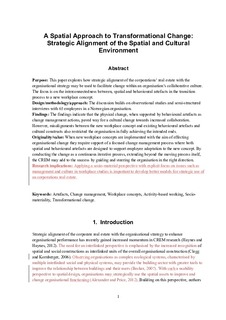A spatial approach to transformational change: Strategic alignment of the spatial and cultural environment
Journal article
Submitted version
Permanent lenke
http://hdl.handle.net/11250/2480888Utgivelsesdato
2017Metadata
Vis full innførselSamlinger
Sammendrag
Purpose
The purpose of this paper is to explore how strategic alignment of the corporations’ real estate with the organisational strategy may be used to facilitate change within an organisation’s collaborative culture. The focus is on the interconnectedness between spatial and behavioural artefacts in the transition process to a new workplace concept.
Design/methodology/approach
The discussion builds on observational studies and semi-structured interviews with 65 employees in a Norwegian organisation.
Findings
The findings indicate that the physical change, when supported by behavioural artefacts as change management actions, paved way for a cultural change towards increased collaboration between employees and across hierarchical levels. However, misalignments between the new workplace concept and existing behavioural artefacts and cultural constructs also restricted the organisation in fully achieving the intended ends.
Research limitations/implications
Applying a socio-material perspective with explicit focus on issues such as management and culture in workplace studies is important to develop better models for strategic use of a corporations’ real estate.
Originality/value
When new workplace concepts are implemented with the aim of effecting organisational change they require support of a focused change management process where both spatial and behavioural artefacts are designed to support employee adaptation to the new concept. By conducting the change as a continuous iterative process, extending beyond the moving process itself, the corporate real estate management (CREM) may add to the success by guiding and steering the organisation in the right direction.
